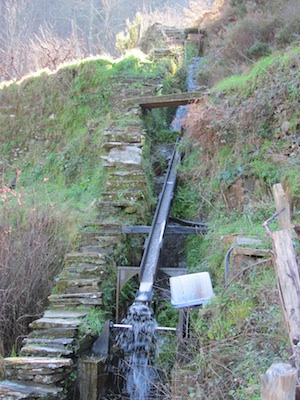... the Hurricane CAT 5 http://www.hurricanewindpower.com/servlet/the-175/low-wind-PMA-,/Detail is probably the closest match for what you're looking for with the lower RPMs and higher potential amprage.
Spencer, the Hurricane low wind PMA is a re-badged Presto Wind alternator (we wrote to Hurricane and asked because they looked suspiciously similar). I think Hurricane may specify different windings on one or two of 'their' alternators, but after our experience with the Presto Wind M-24s (see above), I wouldn't go down that road again.
As far as I can gather, what you say is true of a lot of servo motors, but the F&P and ECMs are adjustable (as per Chris's post above) so it's these I'm looking at just now.
In the process of doing so, I came across Jonathan Kraidin's F&P modifications (
http://www.mindchallenger.com/wind/) and as a result got very curious about axial flux alternators. Having looked at the record of his build, Hugh Piggott's manual, and Dan & Dan's improvements, this is certainly something we'd be capable of doing, so can someone possibly encapsulate in a single paragraph what pros and cons an axial flux alternator has vs a modified F&P or ECM? Am I right in thinking they're a lot more efficient?
This is all starting to feel pretty good, so I have some more questions for those who have a lot more experience in these things than I do.
I mentioned in my initial post that I'd been studying calculations for water turbines, water wheels and wind turbines to try and derive an appropriate equation for calculating the power of the wheel. I'd like to run this by you and ask whether it sounds reasonable since clearly I'll need to be confident about this in order to get the generator side of things right. Because the wheel doesn't behave like 'normal' water wheels and is driven more by incident velocity than weight of water, the equation I've used to work out the available power at the shaft is:
Weight of water in buckets in kg x vertical drop in m x water speed in m3/s3 x efficiency
Each bucket holds 3 litres of water and there's roughly 3 full buckets' worth in the wheel at any time. Vertical drop is 1m. Efficiency I've taken to be a constant 0.85, though it's higher at lower volumes and lower at higher volumes due to the changing arc of the water and the angle it hits the wheel.
Velocity of water in chute at 2 litres per second = 2.7m/s
Velocity of water in chute at 3 litres per second = 3.2m/s
Velocity of water in chute at 4 litres per second = 3.6m/s (extrapolated from previous 2 readings - we've had hardly any rain this winter ...)
This gives 151W at 2l/s, 244W at 3l/s and 369W at 4l/s at the shaft. Subtracting a conservative 50% generating losses, this gives expected output of 75W, 122W and 184W respectively. It feels like a decent baseline to me, based on observations of the prototype and what it's producing. The engineer reckons higher, and he may be right, but I'm being deliberately conservative.
And since a picture is worth 1000 words, here are some photos of the wheel and chute during construction:
Wheel installed on framework

Chute + wheel. Water volumes here are pretty low. The upturned plastic box is, I hasten to add, a temporary cover for the PMA

Volume here probably between 2 and 2.5 litres per second
